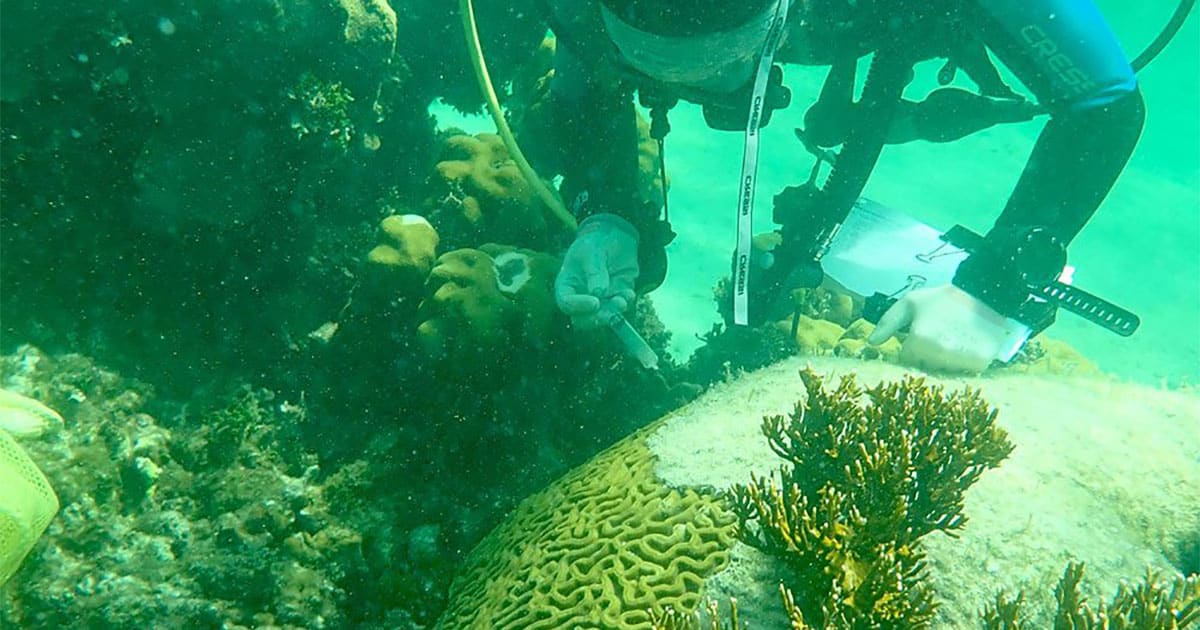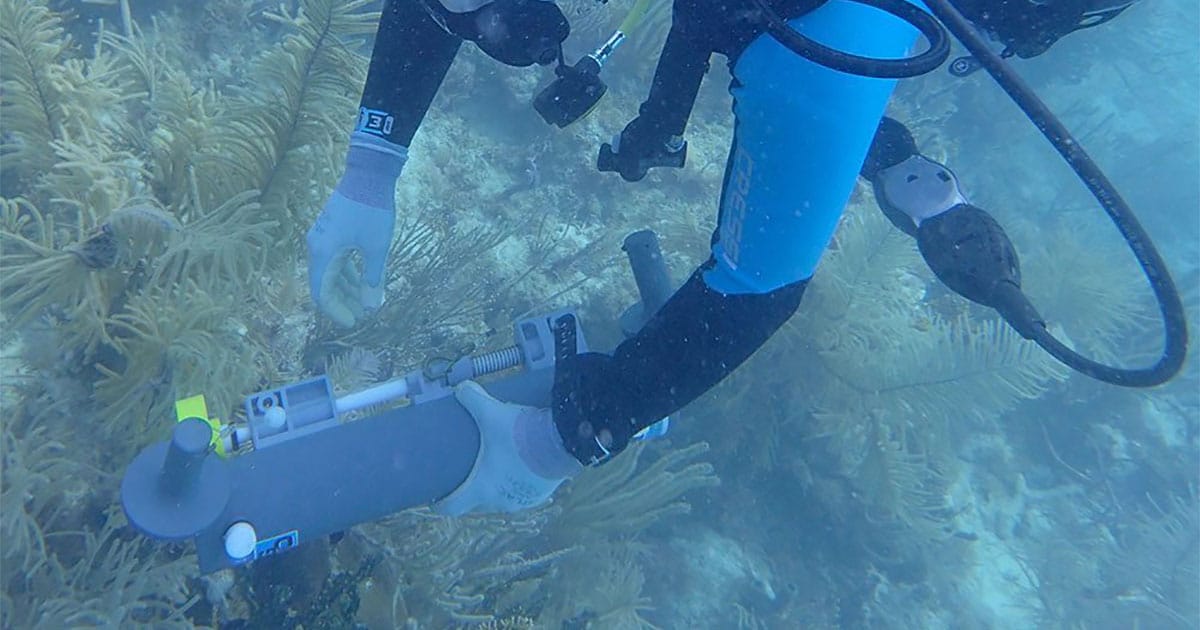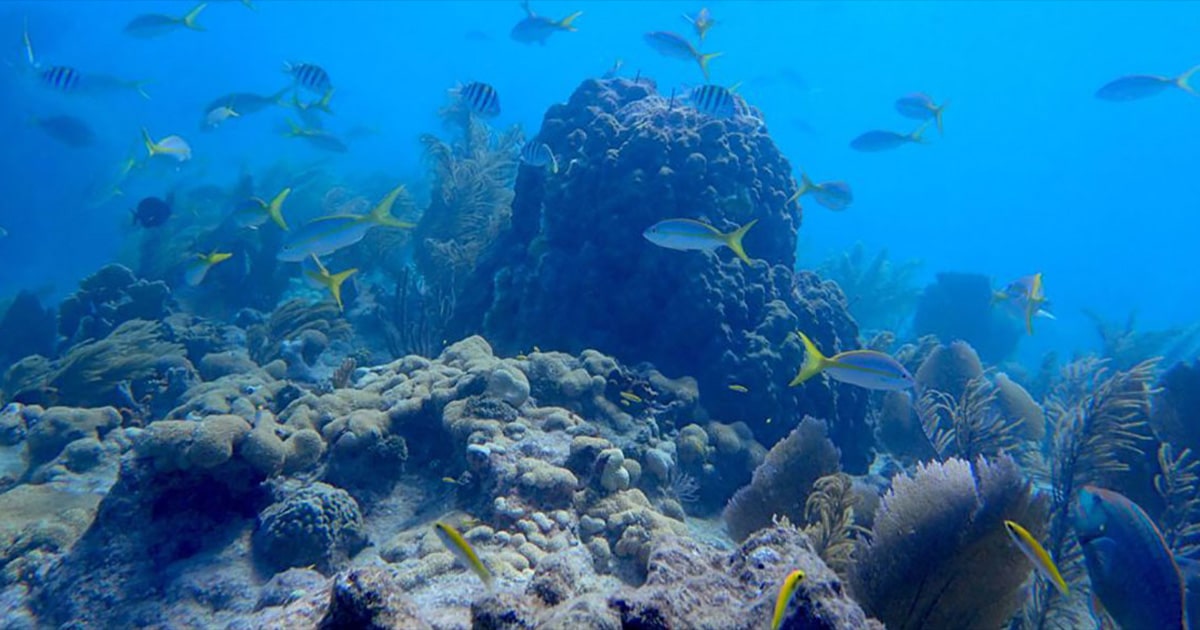The techniques, which look at microbes and dissolved metabolites—i.e., chemicals that are produced during metabolism—were broadly applied to coral reefs off Florida as a new means to examine reef features, with these techniques also having conservation applications, according to a journal article, “Microorganisms and dissolved metabolites distinguish Florida’s Coral Reef habitats,” published in PNAS Nexus and co-authored by researchers at the Woods Hole Oceanographic Institution (WHOI), Mote Marine Laboratory and Aquarium, and the Scripps Institution of Oceanography.
“Microorganisms and the dissolved metabolites they process are central to the functioning of ocean ecosystems. These “invisible” ocean features are poorly understood in biodiverse and productive coral reef ecosystems, where they contribute to nutrient cycling and signaling cues among reef organisms. This study demonstrates that reef water microbes and metabolites successfully distinguish reef habitats, including geographical, reef compositional, and environmental features, and together they provide novel insights into reef ecosystem characteristics,” the article states.
“Microbes and dissolved metabolites offer a new means to examine reef features and have applications for conservation, monitoring, and restoration efforts in these changing ecosystems,” the article continues.
Another important benefit in studying microbes and metabolites is that they can provide a more immediate understanding of reef health, says article co-author Amy Apprill, an associate scientist in the Marine Chemistry and Geochemistry Department at WHOI. “For the most part, the techniques that researchers so far have used to assess coral reef health are visual based. For instance, when researchers see a coral turning white, they know that something has caused it to be stressed,”she said.
“Visual changes on reef reefs tell you what’s already happened in the past. But when we take a measurement of microbes or metabolites, we get a snapshot of current conditions,” said Apprill. “Coral reefs are very dynamic ecosystems. Their health can change rapidly, and microbes and metabolites are basically sensors that can tell us about what’s happening now on a reef and provide more insight into processes than can be obtained from photographs.”
Key Takeaways
- With coral reefs worldwide undergoing unprecedented stressors due to climate change and other human pressures, the application of innovative techniques shows promise for detecting reef health, and could be especially helpful during restoration efforts.
- These new techniques, which look at microbes and dissolved metabolites—i.e., chemicals that are produced during metabolism—of reefs, offer a new means to examine reef features and have broad conservation applications.
- This study demonstrates that reef water microbes and metabolites successfully distinguish reef habitats, including geographical, reef compositional, and environmental features, and together they provide novel insights into reef ecosystem characteristics.
- Microbes and dissolved metabolites offer a new means to examine reef features and have applications for conservation, monitoring, and restoration efforts in these changing ecosystems.
- Coral reefs are very dynamic, and their health can change rapidly, and microbes and metabolites are sensors that can tell us about what’s happening more quickly than we can by just going out and taking photographs of a reef.
 Woods Hole Oceanographic Institution diver Laura Weber uses a syringe to collect tissue from a coral to examine its microbiome, or associated microbial community, in relation to the recent stony coral tissue loss disease outbreak. (Image credit: Cynthia Becker, Woods Hole Oceanographic Institution)
Woods Hole Oceanographic Institution diver Laura Weber uses a syringe to collect tissue from a coral to examine its microbiome, or associated microbial community, in relation to the recent stony coral tissue loss disease outbreak. (Image credit: Cynthia Becker, Woods Hole Oceanographic Institution)
For the study, researchers focused on Florida’s Coral Reef (FCR), a 500-kilometer barrier reef that stretches from north of Miami, Florida down through the Dry Tortugas National Park. During June 2019, researchers examined 85 reefs along the FCR to determine if and how reef water microbes and metabolites differentiate each reef within the context of geography, reef benthos, disease, and environmental parameters. In the study, researchers used four so-called “omic” approaches: taxonomic microbiome via marker gene amplicon sequencing, functional microbiome via shotgun metagenomics, targeted metabolomics, and untargeted metabolomics. To examine the condition of the reefs, researchers collected noninvasive water samples near the reefs. They also conducted taxonomic microbiome profiling of near-coral seawater and coral hosts.
“Our results demonstrate that microbes and metabolites successfully distinguish between individual reefs,” according to biogeographical zones, “and that their combined use provides novel insights into reef ecosystem parameters that may benefit monitoring, conservation, and restoration activities in these important ecosystems,” the article states.
The research was spurred on not only because of the global pressures on coral reefs, but also because of the highly contagious stony coral tissue loss disease (SCTLD). During the time of the study, SCTLD had already affected many of Florida’s reefs, but had not yet reached the distant Dry Tortugas; though, now the disease has reached there as well.
The data set provides an important point in time when the Dry Tortugas were untouched by disease, and this reference could help researchers determine how much the ecosystem may be shifting in the future, Apprill said. The research could provide significant value to the breadth of historic and present research on the FCR reef ecology, according to the article.
“It’s incredibly impressive that this team characterized the microbes, and the molecules they and reef organisms produce, across almost the entirety of Florida’s Coral Reef within just two weeks, ultimately providing a critically important, geographically-focused benchmark to compare with future studies,” said co-author Erinn Muller. She is associate vice president for research at the Mote Marine Laboratory and Aquarium, where she also is the Coral Health and Disease program manager, director of Mote’s International Coral Gene Bank, and senior scientist. “This study highlights associations among the reef community, disturbances such as disease outbreaks, and the reef water’s microbial characteristics. These ‘silent signals’ can provide insight into the health state of our coral reefs in ways previously unexplored.”
“One of the most exciting aspects of this paper is that it is inherently collaborative and interdisciplinary,” said article lead author Cynthia Becker. During the time of this research, she was a Ph.D. student in Apprill’s laboratory at WHOI; Becker soon will be a postdoctoral scientist at the University of Florida. “To conduct the research, we worked with OceanX, Scripps Institution of Oceanography and Mote Marine Laboratory. In the lab and analysis, because of the collaboration and diversity of our skillset, we wove together high-resolution imagery analysis, disease ecology, microbial ecology, and chemical ecology. I think this paper shows how important inter-institution and interdisciplinary research is to understanding important and complex ecosystems like coral reefs.”
 Woods Hole Oceanographic Institution diver Laura Weber collects the water overlying the coral reef using a Niskin bottle. This water was used to study the invisible components of the coral reef, the microorganisms and dissolved metabolites. (Image credit: Cynthia Becker, Woods Hole Oceanographic Institution)
Woods Hole Oceanographic Institution diver Laura Weber collects the water overlying the coral reef using a Niskin bottle. This water was used to study the invisible components of the coral reef, the microorganisms and dissolved metabolites. (Image credit: Cynthia Becker, Woods Hole Oceanographic Institution)
Becker added, “It was exciting to be a Ph.D. student during the trip. It was my first year in the Massachusetts Institute of Technology—WHOI Joint Program in Oceanography/Applied Ocean Science and Engineering, and the trip was an incredible way to network with other scientists and understand the reefs first-hand.”
“Metabolome and microbiome analyses have the potential to revolutionize our understanding of reef processes and energetics, but our understanding of the current data and their implications is limited, and their inclusion into monitoring programs and research studies comes with significant challenges” including access to specialized equipment and expertise, the article states.
Apprill said she is hopeful that the inclusion of these new techniques in monitoring coral reefs can make a difference. “Right now, when reefs are doing so poorly, expanding our toolbox of approaches to be able to study and understand reefs, one of the most biodiverse and complex ecosystems on Earth, is critical,” she said. “Here, we applied innovative omics techniques to Florida’s Coral Reef during a time of significant coral disease outbreak, showed connections between microbes, metabolites and reef features, and provided a knowledge base that may benefit managers and conservation groups working to protect and restore economically and environmentally important coral reefs.”
This work was supported by the Dalio Foundation (now “OceanX”) and funders of the Ocean 5 project, The Tiffany Foundation, the National Science Foundation, and by a National Oceanic and Atmospheric Administration’s Oceanic and Atmospheric Research Cooperative Institutes Award. The study was conducted under Dry Tortugas National Park permit DRTO-2019-SCI-0010, Florida Keys National Marine Sanctuary permit FKNMS-2019-046, John Pennekamp Coral Reef State Park permit 05131925, and Biscayne National Park permit, BISC-2018-SCI-0029.

